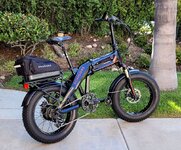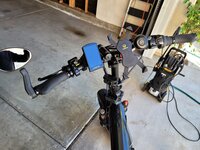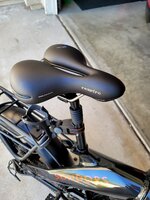Boy from reading a lot of these comments I can see why e bike manufacturers lie about the capabilities of their bikes. If they told the truth, no one would buy their e bike. There is clear misunderstanding of what capable and sustainable mean in the world of machines. Most people cannot be convinced that the lies are not real. The answer is offering short warranties, overpriced extension warranties and every other sentence in the owners manual tells you the damned this is apt to kill you..
E bikes are new and there is not enough common knowledge to about their true capabilities. People believe they have gobs of power for speeds above 20 mph when in truth, e bikes suck on the power side big time. The real truth is they seem powerful because most people don't understand how pathetic human power really is.
Not many people would go out and buy a 300 hp automobile and expect to drive it to near its maximum output for a half hour commute twice a day yet that is the expected norm on a cheap off the shelf e bike. How long do you think the automobile would last? Why expect the e bike to be any different.
My bike has a 1000 watt BBSHD and is run by a huge 2.5KWhr 52 volt battery. The bike is really capable of 18-20 mph with averages around 16-17 mph overall with a range of about 90 miles I can absolutely count on 10mph and 45 miles of range. That is the ultimate capability on any route in any weather.
My bike can easily go 28 mph, but you throw in a 10 mph headwind or a 3-4% grade and you can kiss 28mph good bye. Now I know that a lighter bike and rider would be more capable but that is my current reality.
With my truck. I can go 65 mph with just about any headwind or hill. 65 is probably half the maximum speed. I can sustain half the 28 mph (14 mph) on just about any hill and just about any wind speed I care to ride in.
Bottom line is that I am not uncomfortable with many loose definitions of sustainable and capable but operation of an e bike anywhere near it's maximum rated output does not fly in any my definitions. The reason it bugs me is that I keep getting baited into the glimmering hope that someone on here has stumbled across the holy grail of e bikes only to read between the lines and realize it is not true. I am afraid of pegging the BS meter to the point I won't recognize a true advancement in the world of e bikes.
Sorry for the rant, now I have recharged and can go on taking the bait.
E bikes are new and there is not enough common knowledge to about their true capabilities. People believe they have gobs of power for speeds above 20 mph when in truth, e bikes suck on the power side big time. The real truth is they seem powerful because most people don't understand how pathetic human power really is.
Not many people would go out and buy a 300 hp automobile and expect to drive it to near its maximum output for a half hour commute twice a day yet that is the expected norm on a cheap off the shelf e bike. How long do you think the automobile would last? Why expect the e bike to be any different.
My bike has a 1000 watt BBSHD and is run by a huge 2.5KWhr 52 volt battery. The bike is really capable of 18-20 mph with averages around 16-17 mph overall with a range of about 90 miles I can absolutely count on 10mph and 45 miles of range. That is the ultimate capability on any route in any weather.
My bike can easily go 28 mph, but you throw in a 10 mph headwind or a 3-4% grade and you can kiss 28mph good bye. Now I know that a lighter bike and rider would be more capable but that is my current reality.
With my truck. I can go 65 mph with just about any headwind or hill. 65 is probably half the maximum speed. I can sustain half the 28 mph (14 mph) on just about any hill and just about any wind speed I care to ride in.
Bottom line is that I am not uncomfortable with many loose definitions of sustainable and capable but operation of an e bike anywhere near it's maximum rated output does not fly in any my definitions. The reason it bugs me is that I keep getting baited into the glimmering hope that someone on here has stumbled across the holy grail of e bikes only to read between the lines and realize it is not true. I am afraid of pegging the BS meter to the point I won't recognize a true advancement in the world of e bikes.
Sorry for the rant, now I have recharged and can go on taking the bait.




